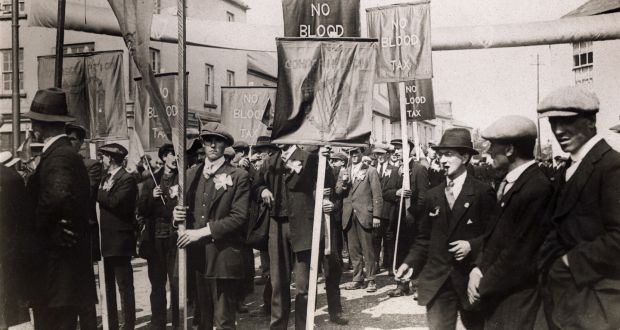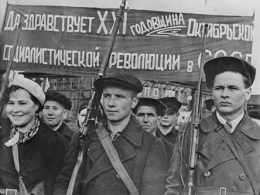April 2018 marks the one hundredth anniversary of a historic general strike in Ireland. Cillian Gillespie looks at the events of this strike and the revolutionary potential that existed in this movement to unite workers north and south.
23 April 1918 was a decisive day in the history of the working-class movement in Ireland. In the words of the self-proclaimed paper of record in Ireland at the time it would be remembered “as the day when Irish Labour found itself” (Irish Times, 24 April 1918). A general strike against the imposition of conscription in Ireland successfully prevented the British ruling class conscripting 150,000 men to fight in the blood-soaked trenches of the First World War. Outside of the North-East of the island industry, transport and services came to a standstill and mass demonstrations took place in cities such as Cork and Limerick.
One immediate question that this poses is: why did industrial action not take place throughout the whole island of Ireland? Most historians speak of the absence of such action in cities such as Belfast and the industrialised parts of the North East as being a foregone conclusion. Implied in their arguments is that it was all but inevitable that the “loyal sons of Ulster” in the form of the Protestant working class would by willingly conscripted into the forces of the crown, or certainly would never join with the Catholic working class in an attempt to resist this.. Opposition to conscription would only come from the Catholic working class of the South and parts of the North. Linked to this argument is the belief in the inevitably of sectarian division and the partition of Ireland itself in 1920, and the formation of two sectarian states in 1922. The events leading up to the strike prove otherwise.
War and revolution
By the beginning of 1918, World War One was entering its fourth year of bloody carnage. This carnage and the suffering that the war was imposing on the lives of working-class people was resulting in growing mass opposition to it in throughout Europe. The most dramatic manifestation of this was the Russian Revolution in October 1917 resulting in the establishment of the world’s first workers’ state, which in turn opened a period of revolutionary convulsion throughout the whole of the continent.
The beginning of 1917 had already seen mutinies on the Western Front by French soldiers against the war itself, and the inspiring impact of the Russian revolution was laying the basis for revolution in Germany and other central European countries in the latter part of 1918. Further afield attempts to introduce military conscription were met with mass opposition. Attempts to do so in Australia failed as a result of the role of the organised working class. The Australian government was forced to organise two referendums on the question in October 1916 and December 1917 respectively. On both occasions the proposition for conscription was rejected.1 In Canada, similar opposition manifested itself in 1917/1918, particularly in Quebec where industrial action and riots broke.
The willingness of working class people to sacrifice their lives in this capitalist war for power and profit was dissipating and giving way to an anti-war sentiment, which was leading in turn in to revolt and revolution. Ireland was not immune from this process. In 1915, recruitment to the British army numbered on average 865 men per week or 45,000 throughout the whole year. At the beginning of 1918 this figure had fallen to 80 men per week.2 No part of the island of Ireland was exempt from this dramatic fall in recruitment numbers. An estimated 49,000 soldiers from Ireland died in the war. By the time the British government sought to impose conscription much blood of working people from Ireland had already been spilled on battlefields such as those of the Somme and Gallipoli.
Growing hardship and radicalisation
At home the war itself was producing considerable hardship for working class people with living standards being eroded as food prices in the war economy that existed in Ireland shot up while wage stagnated. A report from the 1917 conference of the Irish Trade Union Congress and Labour Party (ITUC&LP), said that food and fuel prices had risen by 84% since the beginning of the war.3 This conference, held in Derry’s Guildhall in August of that year, brought together working class representatives from across Ireland and reflected the mood for the unity of the working class, as shown by its resolution (that was unanimously passed) re-affirming its opposition to partition:
“That this Congress, representing the workers of Ireland, declares that any attempt to divide the workers of this country by introducing Partition in any form, temporary or permanent, will be resisted by organised labour as being destructive of the Unity and Solidarity of the Irish Labour Movement.”4
On the question of the introduction any attempt to introduce conscription it declared:
“We repeat our determined antagonism to Conscription, and solemnly affirm our intention, to quote the words of the Ulster Covenant, ‘Of using all means which may be found necessary to defeat the present conspiracy’ to extend the Military Service Act to Ireland.”5
Reflecting the fact that opposition to the war was emerging in Britain, Labour Party Councillor P.T Daly reported the Scottish Trade Union Congress, at its recent conference that he had attended, had moved a resolution “condemning the conscription of Labour”.6
The 1917 conference was taking place against the backdrop of growing industrial action as the workers’ movement quickly overcame the setback of the outcome of 1913 lockout. Membership of the Irish Transport and General Workers Union (ITGWU) had risen to 68,000 by the end of 1918, from a low point of 5,000 at the time of James Connolly’s execution in 1916. This was more than double that which it achieved at its initial highpoint on the eve of the lockout under the dynamic leadership of James Larkin.
Like their brothers and sisters in the rest of Europe, working class people were also being inspired and radicalised by the impact of the Russian Revolution. On 4 February 1918, a crowd estimated at 10,000 came to a meeting in Dublin’s Mansion House to commemorate this event. The papers of the Irish labour movement which had a mass circulation such as Irish Opinion (later renamed The Voice of Labour), the paper of the ITGWU, also reflected this pro-revolutionary sentiment in their press.
Outside of the North-East of the country, working class people were being radicalised by the impact of 1916’s repression and the reprisals by British imperialism that ensued afterwards. This was resulting in support for newly re-established Sinn Féin which won a series of by elections in 1917. Like Edward Carson’s Unionist Party, the nationalist representatives of southern Irish capitalism in the form of the Irish Parliamentary Party (IPP) had enthusiastically supported the war and its leader John Redmond urged members of the Irish Volunteers to join the British army.
Sinn Féin sought to exploit the growing anti-war mood to cut across the dominance of the IPP as shown in the widely distributed postcard they produced in this era playing on the fact that Redmond had been utilised in recruitment posters for the British Army from 1914 onwards (see below). In a by election in South Armagh they used the text underneath stating: “Do you want your boys to live in Ireland instead of dying in France, Flanders, Eqypt…A vote for McCartan [the Sinn Féin candidate] is a vote against conscription.”7
Conscription introduced
In the Spring of 1918 German imperialism launched a major counteroffensive on the Western Front, hoping to gain a military advantage before US troops (the US had declared war on Germany in April 1917) arrived in Europe. The Military Services Act had introduced conscription into Britain in January 1916, though Ireland was exempt, however now the British government sought to do so as well as raising the military age to 51. This decision was met with immediate opposition on a mass scale.
The first public display of this took place in Belfast on 14 April 1918 where an anti-conscription demonstration took place, organised by the labour movement in Belfast. In a debate on conscription the following day in the House of Commons the Belfast Nationalist MP Joe Devlin reported that the demonstration numbered 20,000 in size and was comprised mainly of Protestant workers.8 The following Thursday, another demonstration of 3,000 took place in Belfast along with other towns in Down and Antrim. Reflecting, albeit in a somewhat distorted manner, the mood for unity of the working class in Ballycastle, Co. Antrim Protestant and Catholic workers marched together with bands playing both the nationalist tune A Nation Once Again and the unionist tune The Boyne Water.
Following its introduction all different sections of the labour movement in the North declared against the introduction of conscription. This included unions representing the shipyard workers in Beflast, that were mainly Protestant in their composition, and again in the Electrical Trades Union, only eight of whose 520 members voted against opposing it. Both the Belfast and Derry Trades Councils came out against conscription, as did that of Omagh, a town with a large army barracks.9
A Presbyterian Minister in Ballycarry, Co. Antrim said he reported at the time that he was convinced that: “the Presbyterian youth of the North did not want conscription any more than the Catholic youth of the South”.10 An indication of the scale of the opposition to conscription was a report given by a commander of the Irish Volunteers in Tyrone at the time:
“One very unusual feature of the conscription campaign in our part of Co. Tyrone was the fact that a number of young Ulster Volunteers came along to us and offered to join the Irish Volunteers in their determination to fight conscription. To my own knowledge, at least four or five came along with others to Join us.”11
The key force in Ireland however that had the authority to unite the working class in a common struggle against conscription were the organisations of the labour movement that organised workers throughout the island. On 20 April, a conference was assembled in Dublin’s Mansion House bringing together 1,500 workers’ representatives and took the decision to organise a general strike against conscription three days later.
The conference reflected not only opposition to conscription but also a mood of internationalism and support for the Russian Revolution. The Voice of Labour described the gathering as: “The greatest and most important conference of representatives of Labour ever held in Ireland.” It sent out a “clarion call” to workers around the country as well “throughout Great Britain, Europe and the World”. It described how the conference had “no parallel outside of Russia…If only Saturday’s had been a Congress of Soviets, and not of Unions! But, as it is, the Unions have done the next best thing.”12
The Bottom Dog, the Limerick based radical socialist paper, said that “dominant notes of the congress” were that “…the ultimate issue of of this question rests with Irish Labour…” and that “this war is not in the interests of small Nationalities, but was begun in the interests of Capitalists…”. Had this conference had representatives from the Belfast labour movement present at it, it would have been the basis for the labour movement to put itself at the leadership of an all-Ireland movement against conscription.13
Potential squandered
However, this potential was squandered by the actions and statements of the leadership of the labour movement. On 18 April, a conference was convened by Dublin Lord Mayor Laurence O’Neill bringing together Sinn Féin, the IPP and ITUC&LP. It was agreed to launch an anti-conscription pledge and a “national cabinet” in which William O’Brien and Tom Johnson of ITUC&LP participated. After the convention a delegation was sent to Maynooth University to seek the approval and support for the campaign from the hierarchy of the Catholic Church.
Such a campaign had the appearance of being an alliance of Catholic nationalist Ireland, in which the labour movement was to politically play a subordinate role, against the imposition of conscription and held no traction for Protestant workers. A postcard produced at the time (see below) about the conscription pledge featured a picture of William O’Brien alongside the leaders of the Sinn Féin, the IPP and Cardinal of Ireland and Archbishop of Dublin. Reflecting their lack of confidence in the ability to unite the working class against British imperialism, no “clarion call” was made by the labour leaders to workers to join the rest of the country in the general strike of 23 April.
Outside of the North-East the strike itself was solid. Businesses, transport and services were all shutdown in Dublin, with the Evening Telegraph (24 April 1918) commenting that “it was not possible to buy a box of matches”. No newspapers were published and there were no deliveries of groceries and bread. The date of the strike came two years after the start of the 1916 rising and fearing the power of the labour movement being mobilised on the streets, the British authorities banned all demonstrations in the city. This was something that the trade union leadership wrongly relented to by refusing to organise a workers’ demonstration in Dublin city centre.
In Cork, as well as most businesses shutting down, 30,000 gathered in the city centre in a demonstration organised by the District Trade and Labour Council. In Limerick, 10,000 took part in a trade union demonstration behind a banner with James Connolly and the slogan “Death before conscription” emblazoned on it. This display of working class power was seen throughout the country with postal services, transport and businesses being shut down in towns and cities across the country with mass demonstrations being organised, combined with this industrial action.14 The Evening Telegraph (24 April 1918) described how:
“In the whole record of Ireland’s connection with England, there has been no demonstration so unanimous, so effective, so dramatic, and so spontaneous as the sudden cessation of work yesterday throughout the country as a protest against conscription.”
While the strike had the backing of the church and nationalist politicians, The Irish Times (24 April 1918) rightly noted that it was:
“the voice of Labour not the voice of religion or of politics, which yesterday stopped the wheels of industry…”
Given the political position adopted by the labour leaders sections of the capitalist class publicly supported the strike, including the Irish Independent that was under the proprietorship of William Martin Murphy. The tool of working-class industrial action was served to bolster the pro-capitalist forces of Irish nationalism and in particularly Sinn Féin.
“historical role of the Irish proletariat..”
This enormous display of the power of the working class, in a part of Ireland where large scale manufacturing was weak, played the decisive in forcing the British ruling class to quietly drop its plans to impose conscription the following month. In the aftermath of the 1916 rising the Russian Revolutionary Leon Trotsky wrote that the “…the historical role of the Irish proletariat is only beginning.”15 The 1918 political strike against conscription was a powerful vindication of this prognosis. In the coming years the working class in Ireland, North and South, was to put its stamp on events through a series of revolutionary strikes such as the Belfast Engineering strike of January 1919 and Limerick Soviet of April of the same year. Membership of the ITGWU surged to 120,000 and workplaces and towns were taken over by self-proclaimed soviets.
In the period of 1918-1920, a historic opportunity existed to carry through a socialist revolution in Ireland that could have defeated imperialism and capitalism on this island. However, the role of the labour leaders in the 1918 conscription strike would be indicative of how this potential was ultimately squandered. They cravenly followed the political lead of Sinn Féin accepting the maxim of “Labour must wait” as shown by their refusal to stand independently in the first general election following the war in the later part of that year. Protestant workers would never be attracted to the Sinn Féin programme of an independent capitalist Ireland.
The refusal of the labour and trade union leaders to politically unite the working class around an anti-capitalist and socialist programme meant that British imperialism could successfully carry through the partition of Ireland. The 1918 general strike had to potential to begin the construction of a working class movement that could have changed the course of Irish history. In marking this event we celebrate a proud moment in out history and one from which decisive lessons must be drawn.












